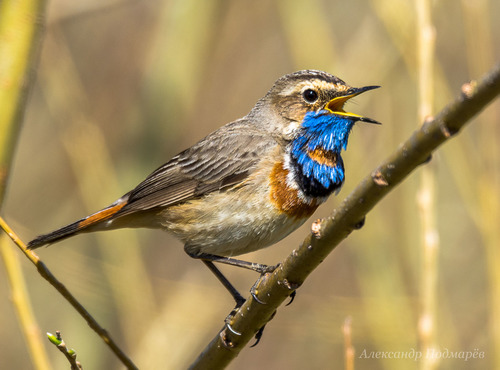
Bluethroat
The Bluethroat (Luscinia svecica) is a small, migratory passerine bird admired for the striking blue and rust-colored throat patch of the breeding male. Belonging to the Old World flycatcher and chat family, it occupies a broad range across Eurasia and even into Alaska. Bluethroats play a significant role in controlling insect populations within their varied habitats. While not globally threatened, certain subspecies face regional declines due to habitat loss and environmental changes. Culturally, the bird's beautiful song and vibrant plumage have made it a subject of poetry and folklore in some regions.
13-14 cm
Length
18-21 cm
Wingspan
Least Concern
Conservation Status
Distribution
Breeds across Europe and Asia, extending into western Alaska. Winters in sub-Saharan Africa, the Middle East, and the Indian subcontinent. Migratory routes vary depending on breeding location, with some populations undertaking long trans-Saharan migrations. Altitudinal range varies from sea level to high mountain meadows.
Lifespan
Typically 2-3 years in the wild, although some individuals may live longer.
Bluethroat's Habitat
Habitat Types
Tundra, Taiga, Shrubby wetlands, Mountain meadows, River valleys, Reedbeds
Climate Zones
Temperate, Boreal, Subarctic, Arctic
Adaptations
Prefers dense, low vegetation for cover and nesting. Adaptable to various wetland and shrubland habitats, showing a preference for areas with moist ground and abundant insect life.
Variations
Numerous subspecies exist (around 10), differing in plumage details, particularly the throat pattern of males. For example, *L. s. svecica* (Red-spotted Bluethroat) has a red central spot on the blue throat, while *L. s. cyanecula* (White-spotted Bluethroat) has a white spot.
Appearance
Breeding Plumage
Breeding males have a bright blue throat (bib) bordered by black, white, and chestnut bands. Females and non-breeding males have a duller throat, often with just a hint of blue or a creamy-white color with a dark necklace.
Seasonal Feather Changes
Males molt into brighter breeding plumage in the spring. After breeding, both sexes molt into a duller, less conspicuous plumage.
Sex Based Plumage Differences
Significant. Males have the distinctive blue throat, while females are generally browner with a less prominent throat pattern.
Notable Features
Bright blue throat patch (males in breeding plumage), Rust-colored tail with dark central feathers, White supercilium (eyebrow stripe)
Diet and Feeding
Primary Foods
Insects, Spiders, Larvae, Berries, Seeds
Foraging Behavior
Forages primarily on the ground, hopping and running to catch insects. Often gleans insects from low vegetation. May also hover briefly to pick insects from foliage.
Specializations
No highly specialized feeding adaptations, but a relatively long, slender bill is well-suited for catching insects.
Seasonal Diet Variations
Diet shifts seasonally. Insects and other invertebrates are dominant during the breeding season. Berries and seeds become more important in the autumn and winter.
Behavior
Social Structure
Generally solitary or in pairs during the breeding season. May form small, loose flocks during migration and in wintering areas.
Communication
Complex song with varied phrases, often incorporating mimicry of other bird species, Sharp 'chack' calls, Visual displays during courtship and territorial defense
Migration
Migratory, with complex routes and timing depending on breeding location. Many populations undertake long-distance migrations, crossing the Sahara Desert.
Territorial or Group Behaviors
Males are territorial during the breeding season, defending their nesting area with song and displays. Outside the breeding season, they are less territorial.
Conservation
Threats
Habitat loss and degradation (wetlands, shrublands), Agricultural intensification, Climate change (affecting breeding and wintering habitats), Pesticide use
Protection Programs
Protected under various international agreements, including the Agreement on the Conservation of African-Eurasian Migratory Waterbirds (AEWA), Habitat restoration and management projects in some areas
Local National Laws
Protected under national bird protection laws in many countries.
Population Trend
Stable
Population Estimates
Global population estimated to be 10-50 million individuals.
Interesting Facts
Bluethroats are known for their impressive song mimicry.
They can incorporate the calls and songs of many other bird species into their own repertoire.
Different subspecies have distinct throat patterns.
This variation helps scientists identify and track different populations.
They undertake long and challenging migrations.
Some populations cross vast distances, including the Sahara Desert, to reach their wintering grounds.
They have been found at 5500m above sea level.
This shows the Bluethroats ability to live in a wide range of habitats.
Faqs about Bluethroat
Where can I see a Bluethroat?
Bluethroats are found in a variety of open habitats with dense, low vegetation, such as wetlands, tundra, and shrublands. They are most easily seen during the breeding season when males are singing.
What is the difference between a Red-spotted Bluethroat and a White-spotted Bluethroat?
These are two subspecies of Bluethroat. The Red-spotted Bluethroat (*L. s. svecica*) has a red central spot on its blue throat, while the White-spotted Bluethroat (*L. s. cyanecula*) has a white spot.
Are Bluethroats endangered?
Bluethroats are classified as 'Least Concern' by the IUCN, meaning they are not currently considered globally threatened. However, some local populations may be declining due to habitat loss.
Copyright @ Nature Style Limited. All Rights Reserved.
 English
English